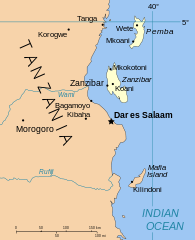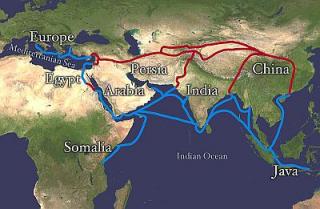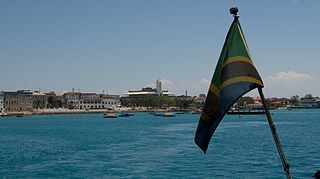
Exploring the history and experiences of mixed heritage persons and inter-racial relationships across the world

Exploring the history and experiences of mixed heritage persons and inter-racial relationships across the world
 The whole of the East African coast from the horn to as far south as Mozambique and the East African islands were once all known as Zanzibar. The word itself is believed to be of Persian or Arabic origin which is hints at the history of this region. It is believed that the Persians would have derived the name from “Zangh Bar” (the Negro Coast) whilst if the name is indeed Arabic , it would come from the term “Zayn Z'al Barr”(Fair is this land). Today, the term Zanzibar relates just to the islands off the coast of and now an autonomous part of the East African country of Tanzania.
The whole of the East African coast from the horn to as far south as Mozambique and the East African islands were once all known as Zanzibar. The word itself is believed to be of Persian or Arabic origin which is hints at the history of this region. It is believed that the Persians would have derived the name from “Zangh Bar” (the Negro Coast) whilst if the name is indeed Arabic , it would come from the term “Zayn Z'al Barr”(Fair is this land). Today, the term Zanzibar relates just to the islands off the coast of and now an autonomous part of the East African country of Tanzania.
Evidence shows that traders from the Arab world were trading all along the East African coast since at least the 1st century AD. These traders hailed mainly from the Eastern part of the Arab world namely Yemen and the Shiraz region of Iran. Western Indian traders are also believed to have been trading in this area at the same time as well. This region was most likely the most southern end of the infamous Silk Road or Silk Route, a network of trade routes that connected vast areas of Asia, the Mediterranean and Europe and many parts of North and East Africa and which existed for over 3,000 years from about 206 BC.
Whilst the archipelago now known as Zanzibar was not particularly rich in the resources the traders sought, it was an ideal base from which to trade with the mainland because of its sheltered harbour. The importance of this trade meant that traders began to settle in larger numbers in the late 11th or 12th century and began inter-marrying with the indigenous locals. They established garrisons on the islands and built the first mosque in the Southern hemisphere. Indeed, the Wahadimu (Hadimu), the Watumbatu (Tumbatu) and the Wapemba (Pemba) peoples collectively known as the Washirazi, claim they are descended from settled merchant princes from Shiraz in Iran. The Washirazi are Bantus and certainly when the traders settled in greater numbers, those that inter-married would have done so with the ancestors of these people.
 However, there is no certainty as to when Bantu people reached the East African coast and it is generally believed that a different people, more likely Somali or Ethiopian, were assimilated or replaced by them in the 1st century AD. The Arabs certainly had knowledge of East African before that and maybe as far back as 800BC. The unknown, possibly Greek, author of ‘The Periplus Of The Erythrean Sea’ generally accepted to be from about the middle of the first century AD wrote that Coast and its islands were settled by Arabs who recognized the King of Yemen as ruler. The works did not mention any black peoples and they were only mentioned in an assumed later works, Ptolemy's Geography, a compilation of what was known about the world's geography in the 2nd century AD, as living in the southern end of modern Mozambique.
However, there is no certainty as to when Bantu people reached the East African coast and it is generally believed that a different people, more likely Somali or Ethiopian, were assimilated or replaced by them in the 1st century AD. The Arabs certainly had knowledge of East African before that and maybe as far back as 800BC. The unknown, possibly Greek, author of ‘The Periplus Of The Erythrean Sea’ generally accepted to be from about the middle of the first century AD wrote that Coast and its islands were settled by Arabs who recognized the King of Yemen as ruler. The works did not mention any black peoples and they were only mentioned in an assumed later works, Ptolemy's Geography, a compilation of what was known about the world's geography in the 2nd century AD, as living in the southern end of modern Mozambique.
Whilst some scholars are sceptical of the Washirazi’s claim to Persian ancestry, the people of Zanzibar as many of the Swahili peoples on the East African coast are generally accepted as being a predominantly mix of Bantu and Arab peoples. Some people will go so far and accept that Zanzibar is the birthplace of the Swahili language and it is there that its purest form is spoken.
The Arab influence remained in place until in August 1505, after Vasco da Gama's visit in 1499, it became part of the Portuguese Empire when a fleet captured the archipelago. The Portuguese tenure was ended after their expulsion from Oman by rebellious tribes and after a 2 year siege of Fort Jesus in Mombasa, Kenya by the Omanis in 1698.
Unlike their other colonies, the Portuguese appear not to have a left a distinct mixed race population in Zanzibar or even on other parts of the East African coast and if they did, it is likely that their descendants would have fled to other parts of the empire after the events in 1698. Zanzibar became part of the overseas holdings of Oman and a lucrative trade in slaves and ivory followed and an expanding plantation economy centring on cloves leading the islands to be known as the Spice Islands, not to be confused with the Dutch Maluku Islands in Indonesia that referred to in the same way.
In 1840, during the reign of Sultan Sayyid Said bin Sultan al-Busaid, the Omani empire’s capital moved from Muscat in Oman to Stone Town on Zanzibar. The sultan not only controlled the islands but also controlled vast parts of the East African coast and inland trading routes. A ruling Arab elite emerged and the sultan’s encouragement of Indian settlement meant that Zanzibar's commerce fell increasingly into Indian hands. Other people of Indian descent known as the Wadebule, who were Islamic people from Dabhol, a port on the west coast of India about a hundred miles to the south of Bombay had settled on the islands between the 1400s and the 1600s. About this time there was a considerable population of Africans from East Africa, locally known as “Siddis”, in that part of India.
 The British involvement may have started earlier but they were responsible for ending the rivalry of the sultan’s sons after his death. One of the sons became the sultan of Oman and the other the sultan of Zanzibar in 1861. Britain influenced the abolishment of slavery in 1873 following a crusade spearheaded by the famous David Livingstone after reporting a massacre in 1871 in the Eastern Congo. Britain’s colonial interests on the African mainland along with other colonial powers such as the Germans and the Italians meant that the Omani’s influence on the coast diminished and eventually British control of Zanzibar via the ruling Arab elite was established when Zanzibar became a British protectorate in 1890.
The British involvement may have started earlier but they were responsible for ending the rivalry of the sultan’s sons after his death. One of the sons became the sultan of Oman and the other the sultan of Zanzibar in 1861. Britain influenced the abolishment of slavery in 1873 following a crusade spearheaded by the famous David Livingstone after reporting a massacre in 1871 in the Eastern Congo. Britain’s colonial interests on the African mainland along with other colonial powers such as the Germans and the Italians meant that the Omani’s influence on the coast diminished and eventually British control of Zanzibar via the ruling Arab elite was established when Zanzibar became a British protectorate in 1890.
The later European colonisers left very little genetic evidence of inter-racial mixing in East Africa apart from a small number in Britain’s settlement colony of Kenya. Zanzibar is no exception and it would appear very little changed until the islands were granted independence in December 1963 as a constitutional monarchy under a sultan. However, even after parliamentary elections, power remained within the hands of the Arab ruling elite despite the mainly African Afro-Shirazi Party (ASP) winning 54% of the vote in the July 1963 election. This resulted in a revolutionary backlash in January 1964 that resulting in the overthrow of the sultan and the government and reprisals against the Arab ruling elite and the affluent Indians. Exact numbers of deaths are unknown but said to be up to 20,000 and many more were expelled or simply fled the country.
The new government of the Republic of Zanzibar and Pemba embraced socialism and in April that year was subsumed into Tanzania. Russian, Chinese and East German communist advisers flocked to the archipelago after the revolution prompting some western critics to refer to Zanzibar as “The Cuba of East Africa.” These advisors were not know for inter-marring into local populations and they appear not have contributed a mixed race population.
Today, the people of Zanzibar are of different origins, mostly Swahili peoples of Bantu origins but there is also minority population of Asians and Arabs and some Europeans. There are bound to be some mixed race individuals but the population is likely to be small and insignificant despite the long history of inter-racial trade and habitation.
LINKS